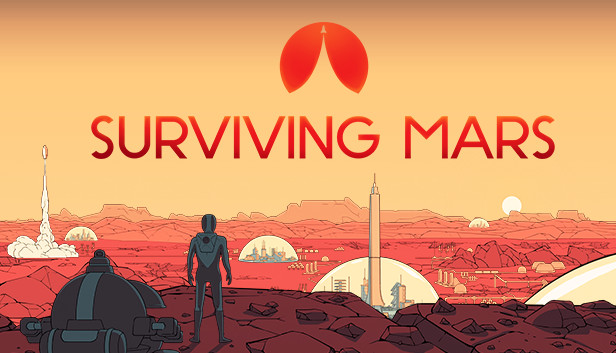How to keep from running out of stuff. I will not be going into depth about base-building, but rather focusing on how to juggle eleventy-seven different resources over the course of 200 sols.
Renewables vs. Craploads
The following resources are renewables:
- Metals, usually
- Rare Metals
- Water
- Polymers, kinda
The following resources are MADE from renewables; they should be treated as craploads in the early-to-mid-game and renewables in the mid-to-late-game:
- Machine Parts
- Polymers, more often
- Electronics
The following resources are craploads:
- Concrete
- Metals, sometimes
Metals and Machine Parts
Domepalooza
Scatter Micro or Small Domes across the map, anywhere with a metal deposit. This will require using Shuttles as the game progresses: while you could micromanage your rovers to move resources around, you won’t be able to do anything about low birth rates or homelessness. Shuttles are the way to go. Good tactic if you have plenty of life-support ability but low research.
Hard Rain
Meteor showers are an EXCELLENT source of metal, and an ongoing renewable as a new Capture Meteors mission spawns every week or so and costs only Fuel. The problem, of course, is that sometime this metal falls ON YOUR HEAD. You can either take your chances and be ready to make repairs, or push the Physics tree to get meteor defense lasers. Either way, this tactic is best for small settlements with strong research.
Machine Parts are produced from metals with an in-dome building that prefers Engineers. As long as you have a good supply of metals, you should not struggle with machine parts. Distributing them is another problem, but there are other guides for transport networks.
Concrete
- Use up all the deposits.
- Use up all your waste rock (convertible into concrete through the Liquefaction tech).
- Run out of things you can flatten to generate more waste rock.
- Run out of money to buy concrete, the game’s cheapest resource, from Earth.
Concrete management is almost always just a matter of getting it where it needs to go, not finding it in the first place.
Water
JUST. USE. VAPORATORS.
Water deposits will run dry at the least convenient moment possible. I am halfway convinced Paradox found a way to program Murphy’s Law into them. If you have deposits, great, suck them up into tanks and store it. Deep water deposits, once you have the tech to extract them, are large enough that you have a decent chance of getting killed by something else first. But in my experience, you’re better off buying vaporators from Earth (they’re actually a pretty cheap prefab) and pushing Biotech research to be able to build your own.
Fuel and Polymers
If you have extra fuel, water, electricity, and workers, you can make Polymers. This, frankly, makes Polymers the easiest of the advanced resources to get. It’s way cheaper than buying them from Earth, and while you can get Polymers from meteor storms, you won’t get enough that way to support a late-game settlement. Maybe not even mid-game. Additionally, the Polymer Factory is the earliest of the three advanced resources to move away from prefabs, and as an outside building it doesn’t take up dome space. The high demand for polymers in batteries and dome maintenance makes it seem difficult, but it’s not as bad as it feels.
One last thing: store your fuel away from everything else. If you are going to be producing and storing large amount of fuel, don’t even use Universal Depots. Fuel stores hit by disasters or random events will EXPLODE, damaging or destroying anything nearby.
Rare Metals and Electronics
F*@! CAPITALISM. MAKE CHIPS.
To a degree, it’s basic math: a Rare Metal sells on Earth for less than an Electronic costs. Therefore, every Rare Metal made into Electronics saves you money, until you’ve hit your maximum usage of electronics. But it’s also the fact that a Rare Metals Extractor will generally produce RM faster than an Electronics Factory will consume it. Therefore, if you maintain a 1:1 ratio of extractors to factories, you’ll always have a small excess of rare metals to export. After all, there are some things you can’t make on Mars until the late game, and you’ll need money to buy prefabs. But I would like to emphasize that RM should not be your primary source of funding. That is what tourists are for.
Rare Metals are a renewable, but an odd one. You can get them from meteor storms, but they spawn in deposits instead of surface nodes. Save some room for expansion in your life-support network in case you need to go get a deposit that’s a little too far away.
The exact point at which you switch from mostly importing Electronics to mostly producing them is going to depend on your map: specifically, how near or far your Rare Metal deposits are. If you happen to land near two large RM deposits, then import a couple Factory prefabs and get to work. Otherwise, keep an eye out for somewhere to expand to that has some.
Takeaways and TLDRs
- Only import stuff you can’t make yourself.
- Meteor storms are the best thing since sliced bread, except terminal-velocity bread won’t kill you.
- Water is annoying but solvable.
- “Advanced” resources are really just “stuff you need a human to make instead of a drone”.
- Whatever resource you’ve convinced yourself is totally under control, that’s the one you’re going to run out of without noticing.
Thanks to Losanguinos for his great guide, all credit to his effort. you can also read the original guide from Steam Community. enjoy the game.

